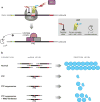Therapeutics based on stop codon readthrough
- PMID: 24773318
- PMCID: PMC5304456
- DOI: 10.1146/annurev-genom-091212-153527
Therapeutics based on stop codon readthrough
Abstract
Nonsense suppression therapy encompasses approaches aimed at suppressing translation termination at in-frame premature termination codons (PTCs, also known as nonsense mutations) to restore deficient protein function. In this review, we examine the current status of PTC suppression as a therapy for genetic diseases caused by nonsense mutations. We discuss what is currently known about the mechanism of PTC suppression as well as therapeutic approaches under development to suppress PTCs. The approaches considered include readthrough drugs, suppressor tRNAs, PTC pseudouridylation, and inhibition of nonsense-mediated mRNA decay. We also discuss the barriers that currently limit the clinical application of nonsense suppression therapy and suggest how some of these difficulties may be overcome. Finally, we consider how PTC suppression may play a role in the clinical treatment of genetic diseases caused by nonsense mutations.
Keywords: nonsense mutation; nonsense suppression therapy; premature termination codons; readthrough.
Figures




References
-
- Ali BH, Al Za’abi M, Blunden G, Nemmar A. Experimental gentamicin nephrotoxicity and agents that modify it: a mini-review of recent research. Basic Clin Pharmacol Toxicol. 2011;109:225–32. - PubMed
-
- Alkalaeva EZ, Pisarev AV, Frolova LY, Kisselev LL, Pestova TV. In vitro reconstitution of eukaryotic translation reveals cooperativity between release factors eRF1 and eRF3. Cell. 2006;125:1125–36. - PubMed
-
- Allamand V, Bidou L, Arakawa M, Floquet C, Shiozuka M, et al. Drug-induced readthrough of premature stop codons leads to the stabilization of laminin α2 chain mRNA in CMD myotubes. J Gene Med. 2008;10:217–24. - PubMed
-
- Amrani N, Ganesan R, Kervestin S, Mangus DA, Ghosh S, Jacobson A. A faux 3′-UTR promotes aberrant termination and triggers nonsense-mediated mRNA decay. Nature. 2004;432:112–18. - PubMed
-
- Arakawa M, Nakayama Y, Hara T, Shiozuka M, Takeda S, et al. Negamycin can restore dystrophin in mdx skeletal muscle. Acta Myol. 2001;20:154–58.
Publication types
MeSH terms
Substances
Grants and funding
LinkOut - more resources
Full Text Sources
Other Literature Sources
Medical

